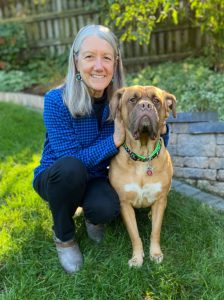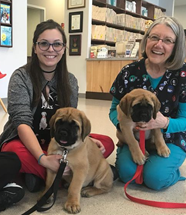
Terry Lackmeyer
Customer Service Representative
Puppies are like little sponges; they watch and listen and learn and soak up so much about the environment around them. However, there is a critical period of learning, between the ages of 3 weeks to 3 months, where what they do or do not experience can set the stage for the rest of their lives.
Behavioral problems are the number one reason people surrender their dogs to shelters. Exposing your new puppy to various people and situations teaches them the world is an interesting and exciting place and there is nothing to fear. That translates to a confident, well-adjusted adult dog ready to share new adventures with their owner.
When introducing your puppy to their new world, be sure to consider their personality and work at their pace. Just like children have different personalities and learn at different rates, puppies are the same way. Some puppies are shy and hesitant about new people and things, others are ready to meet the world head-on and try out every new adventure. It is quite important to move slowly with that shy and hesitant pup. Give them lots of rewards – both treat and pets – and give them plenty of breaks if they seem to be getting stressed or upset. If your puppy is being clingy, yawning, or turning away from the situation, these are signs of stress. Give them a fun break and try again later.
New People
Think of your puppy as a clean slate. They must learn about everything and everyone. When meeting people, try to have them encounter all types of people – both sexes, numerous ethnicities, young and old. Have them encounter people wearing hats and baseball caps, glasses, hoods, and these days masks. Have them meet children but be sure to properly supervisor those meetings. Children can be loud and unpredictable and make sudden movements that could frighten a puppy. Be sure to show the child how to approach the puppy and greet them. Make sure that they touch the puppy gently and do not poke or prod the puppy in a manner that can be hurtful or scary for the puppy.
Car Rides
Be sure to take your puppy various places. It is not unusual for puppies to get car sick, but usually they outgrow this. It is important that you start your puppy with short rides; initially, you may want to just take your puppy around the block. Gradually, increase the distance and length of the rides. You may wish to have someone accompany you on those first few rides to safely hold your puppy. Introduce them to restraints while riding in the car, either via a crate or having them in a car seat or tethered in a safety harness. Again, during those initial restrained car rides, have someone with you to keep an eye on the puppy to ensure they are comfortable and not chewing on the restraints. Eventually, the goal is to have your pet safely restrained and happy so that you can focus on driving.
New Places
If they appear comfortable in the car, begin taking them to new locations. Encourage them to visit with new people they encounter and be sure to give plenty of positive reinforcement. Many establishments welcome puppies, so if there are dog friendly stores, take your puppy in for a visit. Remember to keep the visits short and fun. If your puppy shows signs of stress or fatigue, give them a break away from everything or take them home to rest.
Getting your puppy used to new things does not mean just new people and busy surroundings. Be sure to take your puppy other places as well. Taking them to a quiet country trail with lots of trees will expose them to unfamiliar scents and different experiences. They will experience different textures under their paws and that is important, too. Puppies need to learn to walk on concrete, grass, gravel, dry and wet surfaces. Even letting them walk through a creek or into the edge of a pond is good exposure. They should learn to go outside not only in dry weather, but also rain, snow, and heat as well. You don’t want your puppy to become the diva that only goes outside in perfect conditions.
Home Life
Puppies need exposure to all the household experiences as well. It is important that they become comfortable with regular household sounds – the dishwasher, washing machine, the vacuum cleaner, the oven buzzer, and the rattling of pots and pans. They also need to become comfortable with people coming and going in the home. This is especially important with young children and teenagers. Youngsters and teenagers tend to be loud and boisterous as they enter and leave, and puppies need to learn to be comfortable with that scenario. Watching people remove and put on scarfs, coats, and hats teaches the puppy that these actions are normal and nothing to fear.
Puppies need to learn to accept not only people into the home, but also other canines as well. If you have friends with friendly, well-adjusted dogs, have them bring their dog to your home to meet your puppy. When puppies don’t have the opportunity to meet other canines in the home, they can become territorial adults. Having your puppy encounter other dogs coming into the home teaches them to be accepting and welcoming. Likewise, taking your puppy to the home of a well-adjusted, friendly, adult dog teaches valuable lessons, too.
Solitude
While you are busy being sure that your puppy meets new people and goes to varied places, it is equally important to remember that your puppy needs to learn to stay home alone, too. Start by leaving your puppy for short spans of time. Crate your puppy and leave them with several safe chew toys and never leave a harness or collar of any kind on your pup when crated. Don’t make a big deal about leaving and or returning home. You want your puppy to learn that coming and going is normal and is nothing to fear or worry about.
Puppy Kindergarten
Even if you are totally dedicated to doing everything yourself to socialize your puppy, don’t overlook the value of a well-run puppy kindergarten class led by a qualified instructor. It will require that your puppy have at least one vaccine and the area be disinfected before the puppies arrive to reduce the chance of communicable diseases. Before signing up for the class, you should visit a session to view how the class is presented. Is the instructor watching behaviors as the pups interact and redirecting inappropriate behaviors? Is the class a manageable size? Too many pups can mean that individualized attention may not be possible when needed.
A good puppy kindergarten is not a free-for-all playtime. While there is time for puppies to interact and play, basic obedience should be introduced, too. It is important for puppies to learn to walk calmly on a leash beside you, even with other dogs around. The instructor should teach you how to teach your puppy other basic commands, such as “Come,” “Sit,” and “Down.” Again, puppies need to be able to calmly stand, sit, and lie down with other dogs around them. It is never too early to start the basic education, especially when taught in short sessions, rewarded with treats and playtime. Most importantly, training always should be fun, not a drudge!
Situations to Avoid
While it is necessary to know the right things to do to get your puppy off to a positive start, it is equally important to know what not to do.
- Do not take your puppy to the dog park until fully vaccinated and always pay attention to what’s happening while you are there.
- Do not take your puppy where they will meet stray, sick, or aggressive dogs.
- Do not let your puppy interact with rowdy or aggressive humans. Rough handling by humans teaches puppies to play aggressively or even fear meeting new people.
- Do not take your puppy any place they are not welcome or will become uncomfortable or frightened.
- Never take your puppy any place where they are left unattended – no tying them outside a store or leaving them in a hot car. Remember, if you are too busy to pay attention to your puppy when they are with you, leave them at home!
Puppies are wonderful, fun, and a joy to be around, but they require plenty of time and attention to ensure that they will grow into that wonderful companion dog we all desire. Puppies go through the same stages as human children – babies, toddlers, rebellious teens, and eventually, hopefully, well-adjusted adults. However, it requires time and patience. Don’t think your job will be done in a few weeks or even months – plan on a year or longer to mold that puppy, then adolescent and teenager into that well-behaved dog that everyone will welcome. Socializing your puppy and continuing to train them will ensure both of you will live a happier, healthier life and be a joy to encounter.

